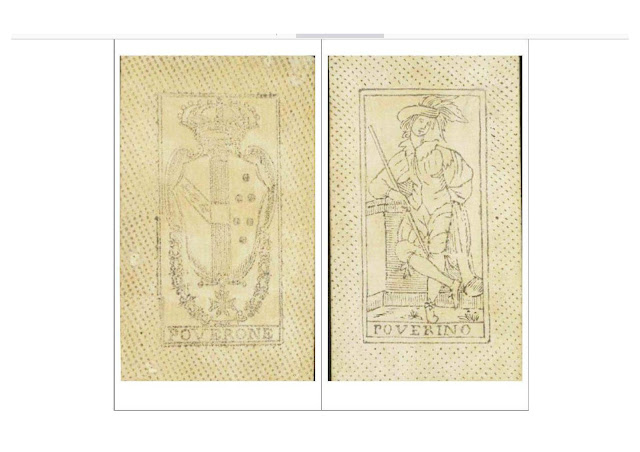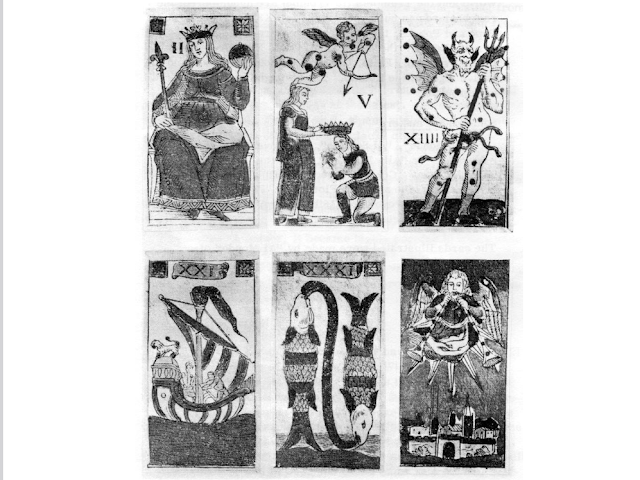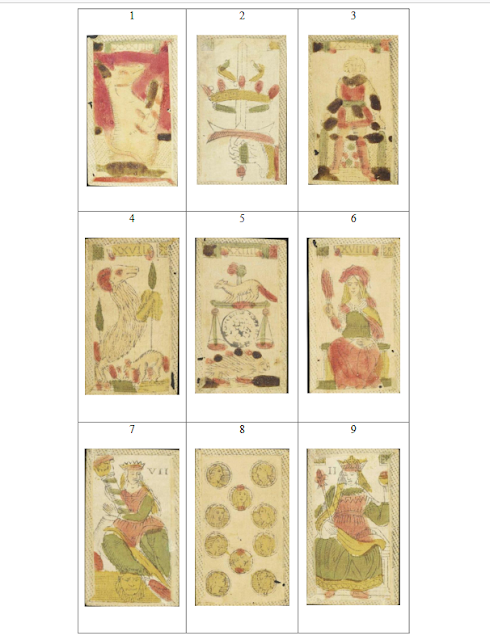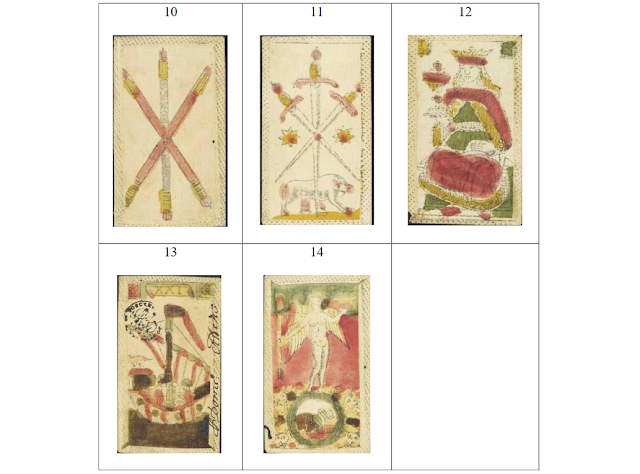Here I present a translation of Franco's note "Quattordici minchiate del Settecento," in Italian at https://www.naibi.net/A/14MINC.pdf, published there on August 20, 2023. It concerns 14 cards attributed by some to Bologna, and to the first half of the eighteenth century. Whether either of these claims is right is subject to his examination. Comments in brackets are mine. Franco has reviewed this translation, and I have adopted the few corrections that were needed. I would add here one other comment. He does not footnote his quotation in section 1, since the Yale catalog (as opposed to the Beinecke, where I could not find it) is readily available online: simply search "minchiate" at https://orbis.library.yale.edu/vwebv/searchBasic.
This translation can also be found at https://forum.tarothistory.com/viewtopic.php?p=26478#p26478, after which I have several posts of my own which I hope take the discussion a little further. Franco's investigation seems to me to raise issues of broad interest, both to those of us concerned with tarot origins as well as collectors: among others, that of how to tell from a set of cards, in the case of a partial deck, what city a minchiate comes from and when it was made. And of further interest, which of two designs for a card, or sets of designs for a deck of cards, is earlier and which later, and which developed from which - unless both developed on parallel tracks from a common ancestor, which then also can be sought.
Fourteen minchiate cards from the eighteenth century
Franco Pratesi
1. Introduction
The fourteen cards that I describe and comment on in this note are
preserved in the Beinecke Rare Books and Manuscript Library with the
same signature as the booklet Regole sopra il Gioco delle Minchiate
[Rules of the Game of Minchiate], which I transcribed and commented on
recently. [note 1] I take the library catalog entry from there.
Title on cover of rules: Regole sopra il Gioco delle Minchiate. In Italian.
Purchased from Bernard Quaritch, Ltd., on the Mary Flagler Cary Fund, 2010.
Collection that includes manuscript rules by an unidentified author, possibly in Florence, Italy, for playing the card game minchiate, circa 1700-1750, as well as fourteen contemporary hand-tinted printed playing cards made by “Al Poverone,” a card maker active in Bologna, Italy, during the eighteenth century.
For these playing cards, I think it is necessary to go into more detail
in the description. First of all, it is said that the set only entered
the library in 2010, which may explain why no specific studies have yet
been carried out on the subject.
A fund established by Mary Flagler Cary (1901-1967), granddaughter of Henry Morrison Flagler, [note 2]
one of the founders of Standard Oil, was used for the purchase; it is
not surprising that this lady was able to leave a fund of 72 million
dollars for charity. It seems that she was particularly passionate about
parks and music, so that a large part of the funds were allocated to
those two activities; but different cultural initiatives were not
neglected either, with assistance to cultural institutes, museums and
libraries.
More important for us is the provenance, because the antiquarian
bookshop Bernard Quaritch Ltd of London is famous, having been in
business for almost two hundred years. [note 3]
I thought that the provenance of these objects could be traced from the
archives of the London bookshop, and I asked for information; they
kindly sent me one of their pages from 2010 in which the material was
illustrated in greater detail, but as to the origin, they wrote that it
was a private purchase, so they could not tell me the provenance.
2. The two backs of the cards
As regards the backs, only two of the fourteen cards have at the bottom
the writing POVERINO, while all the others read POVERONE (see figure)
[both mean “poor person,” although the former suggests more a person of
unfortunate destiny than meager economic condition]. They are two
"trademarks" that are encountered quite often - especially the second -
and are usually attributed to Bolognese card makers of the eighteenth
century, including some dating back to its first twenty years. It is
therefore not surprising if the Beinecke Library suggests a dating
window of 1700-1750, which is also quite wide, and a provenance from
Bologna, as was also indicated in the description of the bookshop from
which they had purchased them.
Since these cards were found together with the pamphlet of Regole sopra il giooco delle minchiate,
which has been indicated as having a probable Florentine origin, it
would be assumed that in Florence they had used a minchiate obviously of
the Florentine type, but produced in Bologna. This wouldn't be too
strange, because in fact there were many minchiate products from Bologna
that arrived in Florence, even regularly paying the requisite taxes if
local production wasn't sufficient, or perhaps if slightly different
models were preferred. [note 4]
____________________
1. https://naibi.net/A/REGMIN.pdf
2. https://en.wikipedia.org/wiki/Henry_Flagler
3. https://www.quaritch.com/about/our-history/
4. F. Pratesi, Playing-Card Production in Florence. Tricase (LE) 2018.
2
From: Rules and Playing Cards for Minchiate.
General Collections, Beinecke Rare and Manuscript Library,
Yale University ‒ The two different backs of the 14 cards
Overall, these backs represented a challenge for my memory, because they
were familiar to me in the Florentine context, and I did not remember
where I had encountered them; in fact, I had seen them in a distant
time, but in a nearby place: the Biblioteca Nazionale Centrale [National
Central Library] of Florence. [Note 5]
However, let us think about what we observe here. If on the back we move
from the name to the figure, in the case of POVERINO, what is indicated
is in itself ambiguous: it is "simply" a young man standing leaning
against a pillar, and his clothing, although elegant enough, I don't
think can safely be connected to a given location. In short, either we
know other examples with certain provenance with which to associate
decks and cities, or we remain vague. However, if we move on to the
twelve backs of POVERONE, the figure is extremely indicative: it is none
other than the grand-ducal coat of arms of the Habsburg-Lorraine of
Tuscany.
Coat of arms - Habsburg-Lorraine-Tuscany - On the smooth shield the coat of arms is depicted in three parts: on the left the Habsburg arms with a red transverse band on a solid gold background; in the center the Lorraine coat of arms with a red stripe divided by white in its center; on the right the Medici coat of arms with six balls, three of them on a solid gold background. [Note 6]
We know that the Medici dynasty died out in 1737 and was followed by the
Habsburg-Lorraine dynasty. In short, as regards the date, this coat of
arms can make us exclude a dating of our
________________
5. https://www.naibi.net/A/06-BURGUN-Z.pdf da: The Playing-Card World, No. 50 (1987) 3-4.
6. https://catalogo.beniculturali.it/detai ... 0900157573
3
cards prior to 1737, but it does not provide us with a second useful date to close the window of possible dates.
The situation regarding provenance is more precise. In theory, one might
think that a card maker from Bologna, when producing minchiate for the
Tuscan market, would consider it suitable, if not also respectful, to
print that coat of arms on the back. Nowadays there are many such
operations; however, I don't think that this would have been accepted in
Tuscany at the time. In short, I believe that that coat of arms was
hardly compatible with a Bolognese production; indeed, I go so far as to
hypothesize that if POVERONE was the trademark of a Florentine card
maker, POVERINO should be too, at least for these cards.
3. The depictions on the cards
Before examining the cards one by one, some general observations can be
made. The description of the bookseller who sold the cards to the
library provides several details taken from specialist literature;
perhaps what most precisely identifies the type of minchiate is the
reference to Pattern Sheet 28 of the International Playing Card Society.
From: Rules and Playing Cards for Minchiate.
General Collections, Beinecke Rare and Manuscript Library, Yale University ‒ first nine cards
5
From: Rules and Playing Cards for Minchiate.
General Collections, Beinecke Rare and Manuscript Library, Yale University ‒ last five cards
The following table lists all the cards with their identification; the progressive numbering is arbitrary and simply follows the order in which they were digitized.
6Of the fourteen cards, nine are tarocchi [trumps, major arcana] and five belong to the four suits - one of each suit and one of spades. The sequence of tarocchi present is 2, 7, 19, 21, 24, 27, 32, 34, (39) and appears completely random. As a general type of these cards, we can agree with the London bookseller's presentation and follow the lead of Pattern Sheet 28 of the IPCS; in the figure, I have presented half of the cards selected there. The general type is this; let us review them one by one.
1. The position of the Bull, which seems to be sitting, is strange, but it is typical of this minchiate card.
2. Here too, the fist holding the sword and the crown are typical.
3. The coloring in Aquarius appears rough, but this is not uncommon.
4. It belongs to the Zodiac series, absent in standard tarot cards.
5. The most notable thing is the central beam. This card was indeed used for the stamp, from 1701 to 1706, but that was different. From here, I couldn't indicate a date.
6. Capricorn belongs to the Zodiac series, absent in standard tarot cards.
7. To represent Strength you could not make a thicker column to break or choose an animal more ferocious than the lion as an opponent.
8. I don't know if the faces drawn inside the coins were intended to give the idea of the heads on the coins, or if it was a decoration in itself, but this was the common way of indicating the suit. The ten "coins" are grouped five above and as many below.
9. This card was also called The Grand Duke; it has no exact correspondent in standard tarot.
10, The batons designed as batons of command, linear and intertwined, were still typical of the Italian-Portuguese model.
11, Intertwined swords were also typical of the Italian-Portuguese model. I can't imagine a route from Lisbon to Florence, instead of the opposite.
12, The cup with the flower on it is a common variant of the suit emblem. This card and the previous one belong to the Poverino deck, different, but you wouldn't notice the difference without seeing the back.
13, Water, one of the four elements. Here the stamp is very indicative, as is the signature on the side, by Domenico Aldini, and will be used in the following.
14, The World was part of the “Arie,” with no number indicated, and was the second-highest card in the deck.
The presence of the stamp on card XXI should allow for a more precise dating, but with my data one can only conclude from the signature that the deck dates to after 1751, when Aldini had his first contract. [note 7] However, I found that Alberto Milano had already studied the question a few years earlier, and his results can be used: the range of possible dates is wide and goes from 06.30.1752 to 12.30.1780. [note 8] While waiting for further information, we can meanwhile use an average value and tentatively date these cards to 1765; if evidence is later found to attribute them to a different year, it will not be by much.
5. Conclusion
Fourteen minchiate cards preserved in the Beinecke Rare and Manuscript Library were shown and discussed, and several clues were highlighted that lead to the correct assumption of a Florentine provenance and a dating around the year 1765.
The general model corresponds to the first minchiate model, the oldest known, the one that remained in use for centuries. I have not been able to indicate possible original ideas in the
_____________________
7. https://i-p-c-s.org/pattern/ps-28.html PATTERN SHEET 28 Suit System: IPT. Recommended Name: the Earlier Minchiate pattern. This pattern was originally classified as IPT-1. This pattern is found on the earliest known Minchiate cards, dating from the 17th century, and may well have been used for them from the first invention of the game.
8. A. Milano, The Playing-Card, 10 (1982) 102-106.
7
individual cards; possibly a specialist will be able to point out other useful details; for example, Nazario Renzoni has already pointed out to me that in the last card, the angel standing above the world appears here, unusually, female. The question is that within a current typology any card maker was free to introduce his own detailed adjustments, precisely those small differences that could make one production more appreciated than another.
Changing the general model was more difficult due to the known resistance to changes of players who usually remain faithful to traditional models for a long time. However, it is known that, even for minchiate, different general models were introduced in subsequent times. It is no coincidence that Pattern Sheet 28 also corresponds to the name of Earlier Minchiate pattern, which will be followed by at least one that is different, but this circumstance goes beyond my current commitment.
Florence, 08.20.2023





No comments:
Post a Comment